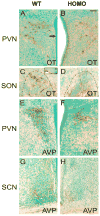Fibroblast growth factor signaling in the developing neuroendocrine hypothalamus
- PMID: 21129392
- PMCID: PMC3050526
- DOI: 10.1016/j.yfrne.2010.11.002
Fibroblast growth factor signaling in the developing neuroendocrine hypothalamus
Abstract
Fibroblast growth factor (FGF) signaling is pivotal to the formation of numerous central regions. Increasing evidence suggests FGF signaling also directs the development of the neuroendocrine hypothalamus, a collection of neuroendocrine neurons originating primarily within the nose and the ventricular zone of the diencephalon. This review outlines evidence for a role of FGF signaling in the prenatal and postnatal development of several hypothalamic neuroendocrine systems. The emphasis is placed on the nasally derived gonadotropin-releasing hormone neurons, which depend on neurotrophic cues from FGF signaling throughout the neurons' lifetime. Although less is known about neuroendocrine neurons derived from the diencephalon, recent studies suggest they also exhibit variable levels of dependence on FGF signaling. Overall, FGF signaling provides a broad spectrum of cues that ranges from genesis, cell survival/death, migration, morphological changes, to hormone synthesis in the neuroendocrine hypothalamus. Abnormal FGF signaling will deleteriously impact multiple hypothalamic neuroendocrine systems, resulting in the disruption of diverse physiological functions.
Copyright © 2010 Elsevier Inc. All rights reserved.
Figures




Similar articles
-
Characterisation of endogenous players in fibroblast growth factor-regulated functions of hypothalamic tanycytes and energy-balance nuclei.J Neuroendocrinol. 2019 Aug;31(8):e12750. doi: 10.1111/jne.12750. Epub 2019 Jul 8. J Neuroendocrinol. 2019. PMID: 31111569 Free PMC article.
-
FGF/FGFR signaling in bone formation: progress and perspectives.Growth Factors. 2012 Apr;30(2):117-23. doi: 10.3109/08977194.2012.656761. Epub 2012 Feb 1. Growth Factors. 2012. PMID: 22292523 Review.
-
Factors involved in the migration of neuroendocrine hypothalamic neurons.Arch Ital Biol. 2005 Sep;143(3-4):171-8. Arch Ital Biol. 2005. PMID: 16097493 Review.
-
Fgf signaling is required for photoreceptor maintenance in the adult zebrafish retina.PLoS One. 2012;7(1):e30365. doi: 10.1371/journal.pone.0030365. Epub 2012 Jan 26. PLoS One. 2012. PMID: 22291943 Free PMC article.
-
FGF signaling induces mesoderm in the hemichordate Saccoglossus kowalevskii.Development. 2013 Mar;140(5):1024-33. doi: 10.1242/dev.083790. Epub 2013 Jan 23. Development. 2013. PMID: 23344709 Free PMC article.
Cited by
-
Induction of Functional Hypothalamus and Pituitary Tissues From Pluripotent Stem Cells for Regenerative Medicine.J Endocr Soc. 2020 Dec 2;5(3):bvaa188. doi: 10.1210/jendso/bvaa188. eCollection 2021 Mar 1. J Endocr Soc. 2020. PMID: 33604493 Free PMC article. Review.
-
Fibroblast growth factor 8 regulates postnatal development of paraventricular nucleus neuroendocrine cells.Behav Brain Funct. 2015 Nov 4;11(1):34. doi: 10.1186/s12993-015-0081-9. Behav Brain Funct. 2015. PMID: 26537115 Free PMC article.
-
Direct and indirect roles of Fgf3 and Fgf10 in innervation and vascularisation of the vertebrate hypothalamic neurohypophysis.Development. 2013 Mar;140(5):1111-22. doi: 10.1242/dev.080226. Development. 2013. PMID: 23404108 Free PMC article.
-
TET1 regulates fibroblast growth factor 8 transcription in gonadotropin releasing hormone neurons.PLoS One. 2019 Jul 30;14(7):e0220530. doi: 10.1371/journal.pone.0220530. eCollection 2019. PLoS One. 2019. PMID: 31361780 Free PMC article.
-
FGF8-FGFR1 signaling regulates human GnRH neuron differentiation in a time- and dose-dependent manner.Dis Model Mech. 2022 Aug 1;15(8):dmm049436. doi: 10.1242/dmm.049436. Epub 2022 Aug 16. Dis Model Mech. 2022. PMID: 35833364 Free PMC article.
References
-
- Acampora D, Postiglione MP, Avantaggiato V, Di Bonito M, Simeone A. The role of Otx and Otp genes in brain development. Int J Dev Biol. 2000;44:669–677. - PubMed
-
- Altman J, Bayer SA. Development of the diencephalon in the rat. I. Autoradiographic study of the time of origin and settling patterns of neurons of the hypothalamus. J Comp Neurol. 1978;182:945–971. - PubMed
-
- Altman J, Bayer SA. Development of the diencephalon in the rat. II. Correlation of the embryonic development of the hypothalamus with the time of origin of its neurons. J Comp Neurol. 1978;182:973–993. - PubMed
-
- Alvarez-Bolado G, Rosenfeld MG, Swanson LW. Model of forebrain regionalization based on spatiotemporal patterns of POU-III homeobox gene expression, birthdates, and morphological features. J Comp Neurol. 1995;355:237–295. - PubMed
Publication types
MeSH terms
Substances
Grants and funding
LinkOut - more resources
Full Text Sources

